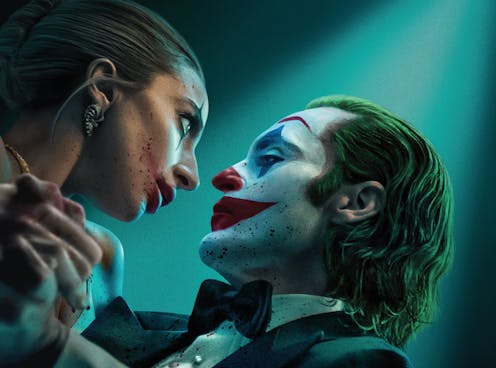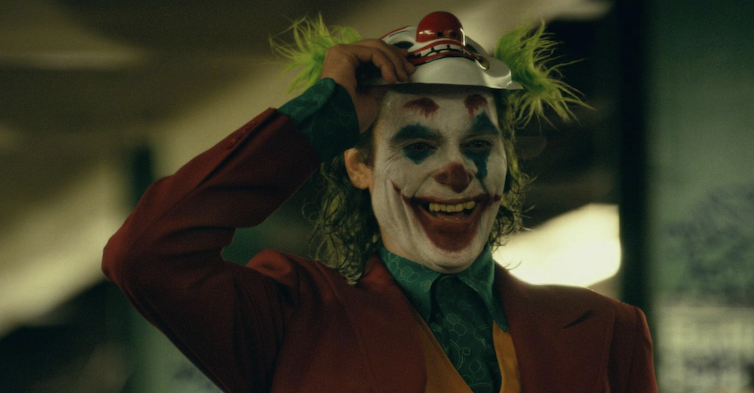
Like two-headed playing cards, Joker stories are about dual identity, doubles and duplicity.
Throughout DC comics and films, the Joker turns others into facsimiles of himself, grinning widely. He shares his state of mind through infectious laughter and mass “clownification”, creating copies as he goes.
Film sequel Joker: Folie à Deux, directed by Todd Phillips and released in cinemas today, participates in this rich tradition. It also challenges it by introducing a Joker haunted by his own lost futures – the glam clown, homicidal entertainer and irresistible lover he could have become.
What can we learn from the Joker character about our cultural fascination with duplication and disintegration?
Madness by imitation
Doubling, split consciousness and double meanings have been ingredients in Joker stories since the character’s creation in the 1940s.
He offers different origin stories himself in the 2008 movie blockbuster The Dark Knight (with Heath Ledger as the Joker). He is presented as many in the recent comic series Three Jokers. The Joker shuffles his own “selves like a croupier deals cards” in the 2007 Batman comic The Clown at Midnight.
Within the DC clowniverse, the Joker turns others into Joker copies and clowns, usually through the use of biological or chemical weapons or poisons, virology, hypnotism or sheer charisma. Joker copies include Joker fans and followers in clown costumes and masks, as in the 2019 film starring Joaquin Phoenix. In comics he is described as having an influence that
[…] affects people, on an almost subconscious, primal level. For most people – regular people – he inspires fear. For the less stable people – he simply inspires.
For more than 80 years, his laughter has spread like a virus and caused mass-clownification countless times.
Multiplying his potency
Joker stories tend to revolve around three scenarios of imitation, doubling and multiplication: several people acting as one (that is, the Joker), one person acting as many (as in Batman: R.I.P. when Batman tries to understand the Joker by experiencing his state of mind like a second consciousness), and a number of personalities nestled within the Joker wreaking havoc. All of these scenarios are powerful reminders clown laughter and humour need not be funny.
The Joker character was inspired by famous films from the 1920s and ’30s, including Robert Wiene’s The Cabinet of Dr Caligari (1920), F.W. Murnau’s Nosferatu (1922), Fritz Lang’s Metropolis (1926), Roland West’s The Bat (1926) and Paul Leni’s The Man Who Laughs (1928). Many of these works feature hapless or unhappy (comic) performers, who all struggle with identity.
The cultural mould to which the Joker belongs is linked with the more than century-old fascination with doppelgangers, male nervousness, violent and involuntary laughter and the loss of agency and sense of the self.

Haunting through absence
The new sequel, Joker: Folie à Deux, draws on all these very Joker traditions. Arthur Fleck and his Joker (Phoenix again) struggles with his split identities.
Set two years after the events of the previous film, Fleck is a patient at Arkham State Hospital, where he meets the dual character Lee Quinzel/Harley Quinn (played by Lady Gaga). She wants him to lean into his Joker self.
Although she is neither the clown nor a scientist as she’s portrayed in other stories, she also wants to be a Joker version. Arthur himself wants to be the Joker, but for reasons both external and internal he ends up not really becoming the Joker we recognise from the first film.
The sequel is ultimately a trick played on the audience. “There is no Joker,” Arthur confirms at the end, just Arthur. Folie à Deux is about a broken dream’s loveliness.
The Joker is a collective dream that fails to come true. He appears in the form of fantasies. He is the past, but at the same time present and absent. This is how the concept of hauntology has been defined – a split between realities. The film glamorises and exploits disillusion as we watch the Joker and his future possibilities disintegrate.
In this way, Joker: Folie à Deux is a clown version of ruin porn, inviting us to enjoy the “decay” of a character. It gives us glimpses of a post-double version of the Joker, a non-Joker, left in pieces.
Joker: Folie à Deux is in cinemas now.
Anna-Sophie Jürgens does not work for, consult, own shares in or receive funding from any company or organisation that would benefit from this article, and has disclosed no relevant affiliations beyond their academic appointment.
This article was originally published on The Conversation. Read the original article.







